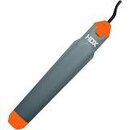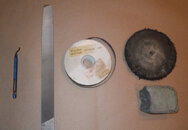cool_hardware52
Contributor
Deburring properly is a chore. At DSS we start with a 2 hp 6 x 48" stationary belt sander and "flat sand" the outside edges, using 80 grit SG or seeded gel abrasives from Norton, they provide better life on Stainless Steel, but at much higher cost per belt.
Next is a 2" x 60" "loose belt" again with 80 grit SG belts that is used to ease and radius the perimeter edges.
The "burr side" or lower face of the plate, i.e. the side opposite the waterjet nozzle will have a "drag burr" and we knock these off with a pneumatic disk sander with scotchbrite disks. The edges are still sharp on the penetrations.
Any round hole is countersunk slightly.
That leaves many non round penetrations. To treat these I built a custom "burr bench" which is much like a router table, but have a high speed Air Turbine spindle in place of the router, like this:

This spindle turns a solid carbide 90 degree included angle burr that we use to finish the edges of the interior slots. To keep the cutter from over heating and loading coolant is delivered to tip.
After all the sanding and countersinking and air spindle deburring is finished the entire plate is run through a vibratory deburring machine the size of pickup truck. That provides a uniform finish and blends any smaller burrs the countersinks and carbide burrs generated.
The cost of abrasives and carbide and a trip to the vibratory total about $25 per plate, and that does not include labor. Proper deburring is hard, time consuming and expensive, no real way around that.
It takes power, a .02 hp dremel isn't going to do much, note the air spindle about is 3/4 hp or greater.
It takes consumables, carbide cutters, and lots of good quality abrasives.
It takes skill, even with the burr bench the operator needs considerable skill to avoid chatter, poor finish and chipped cutters.
Small wonder that off brands sell plates that lack proper finishing.
If I had a sharp plate I'd pass a good "mill bastard" file around the perimeter, countersink the round holes and "shoe shine" the slots with crocus cloth (buy plenty) Then I'd take medium (maroon) scotchbrite and flat sand the entire thing.
Good luck,
Tobin
Next is a 2" x 60" "loose belt" again with 80 grit SG belts that is used to ease and radius the perimeter edges.
The "burr side" or lower face of the plate, i.e. the side opposite the waterjet nozzle will have a "drag burr" and we knock these off with a pneumatic disk sander with scotchbrite disks. The edges are still sharp on the penetrations.
Any round hole is countersunk slightly.
That leaves many non round penetrations. To treat these I built a custom "burr bench" which is much like a router table, but have a high speed Air Turbine spindle in place of the router, like this:
This spindle turns a solid carbide 90 degree included angle burr that we use to finish the edges of the interior slots. To keep the cutter from over heating and loading coolant is delivered to tip.
After all the sanding and countersinking and air spindle deburring is finished the entire plate is run through a vibratory deburring machine the size of pickup truck. That provides a uniform finish and blends any smaller burrs the countersinks and carbide burrs generated.
The cost of abrasives and carbide and a trip to the vibratory total about $25 per plate, and that does not include labor. Proper deburring is hard, time consuming and expensive, no real way around that.
It takes power, a .02 hp dremel isn't going to do much, note the air spindle about is 3/4 hp or greater.
It takes consumables, carbide cutters, and lots of good quality abrasives.
It takes skill, even with the burr bench the operator needs considerable skill to avoid chatter, poor finish and chipped cutters.
Small wonder that off brands sell plates that lack proper finishing.
If I had a sharp plate I'd pass a good "mill bastard" file around the perimeter, countersink the round holes and "shoe shine" the slots with crocus cloth (buy plenty) Then I'd take medium (maroon) scotchbrite and flat sand the entire thing.
Good luck,
Tobin






